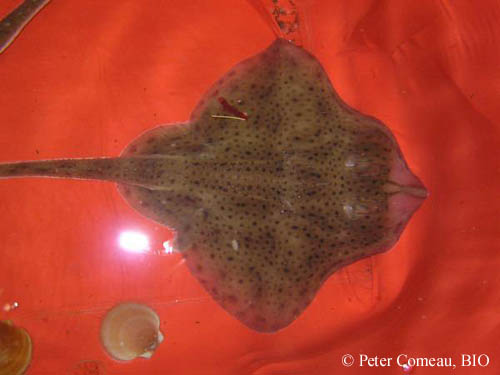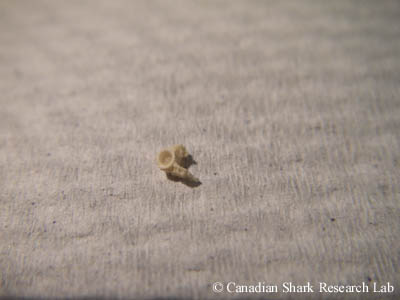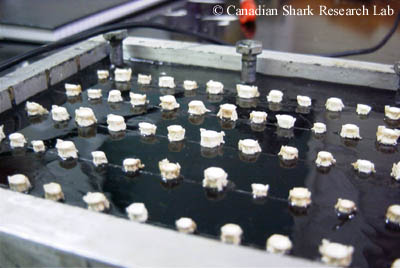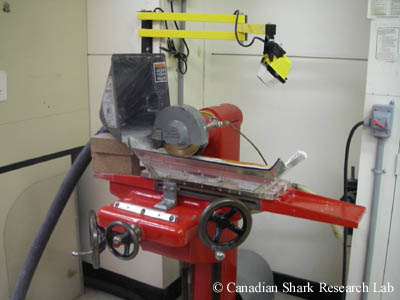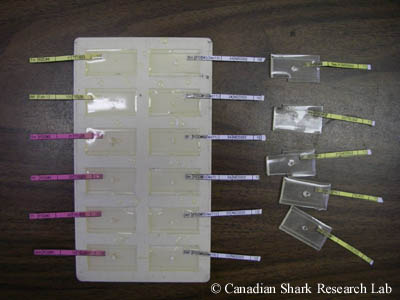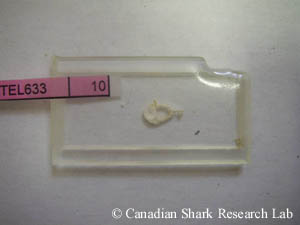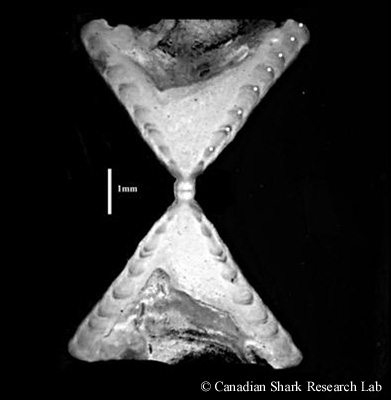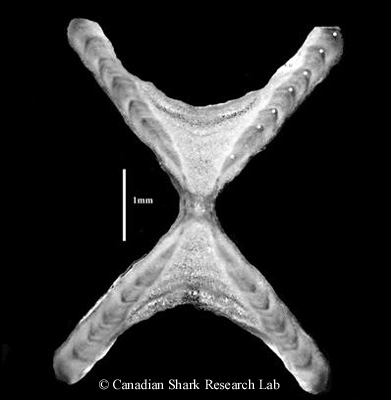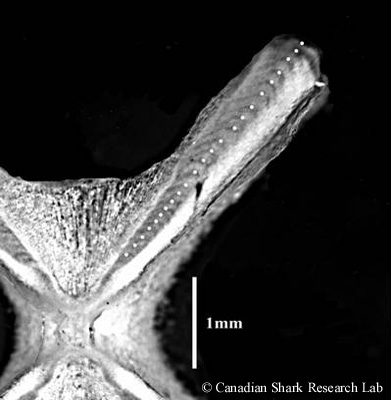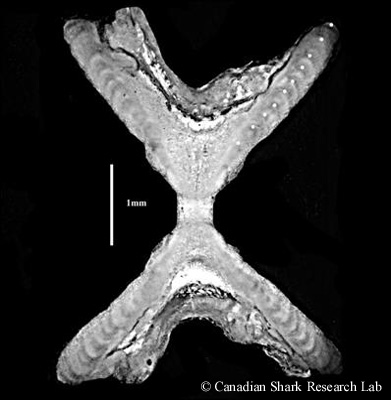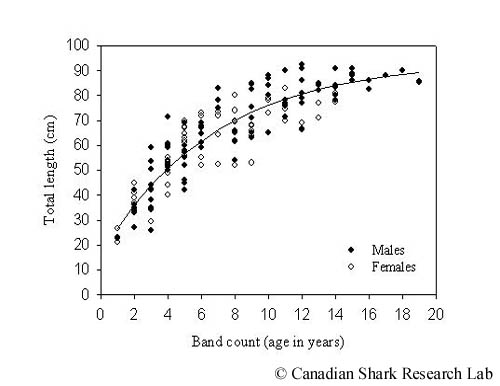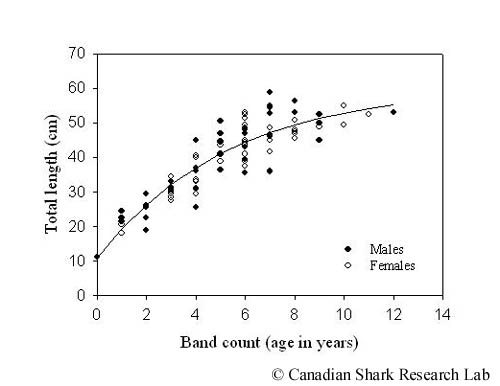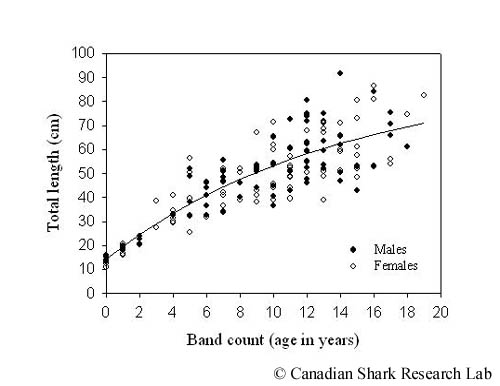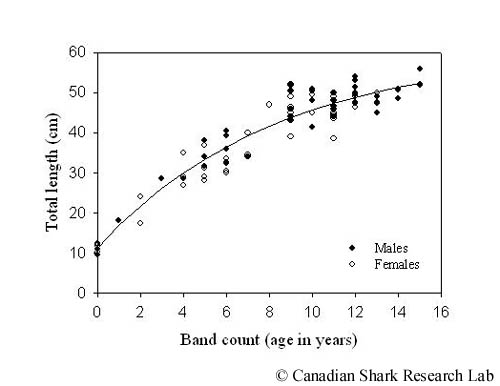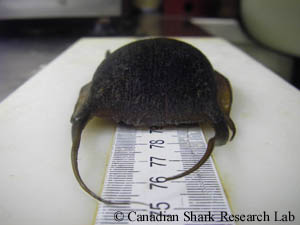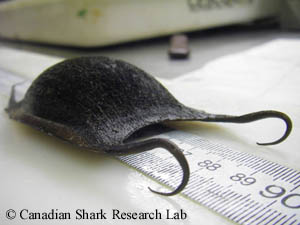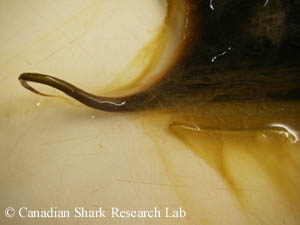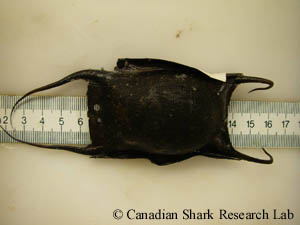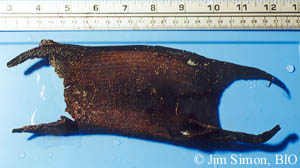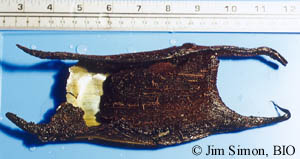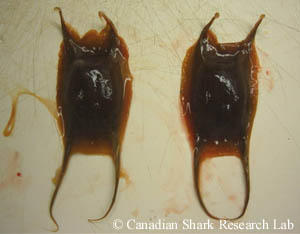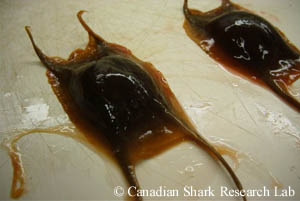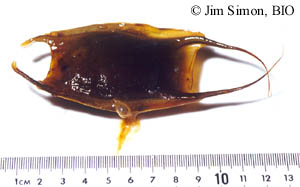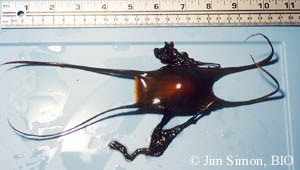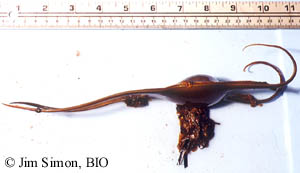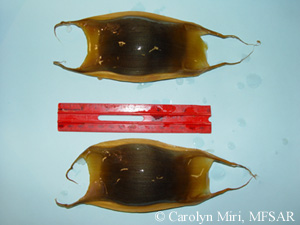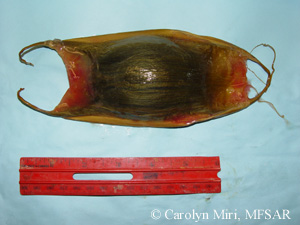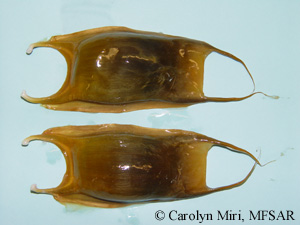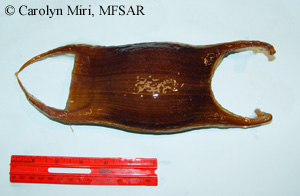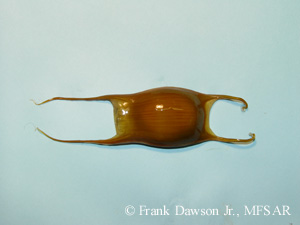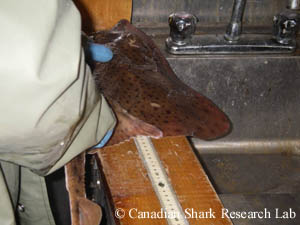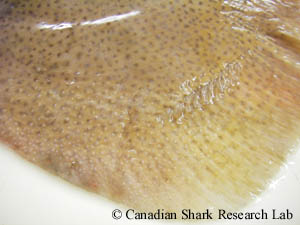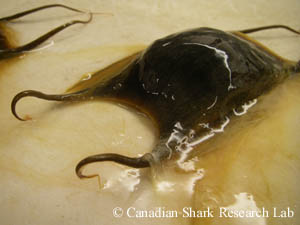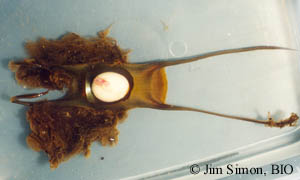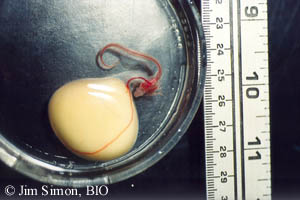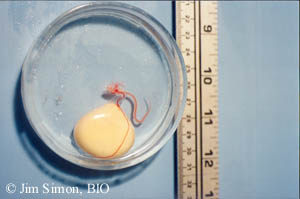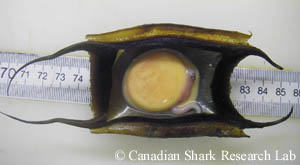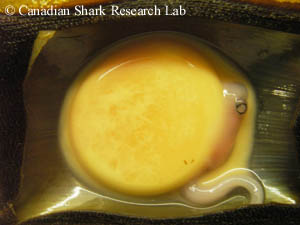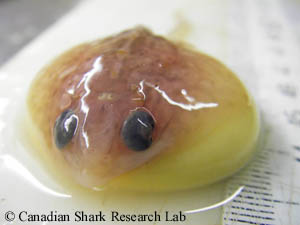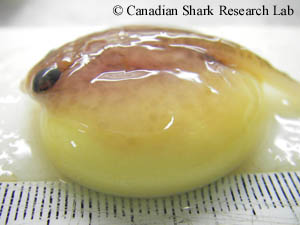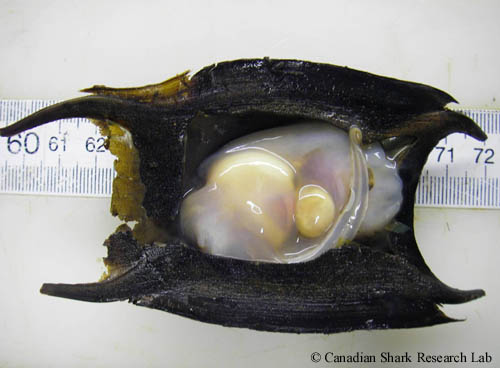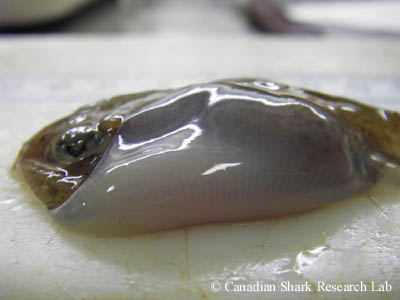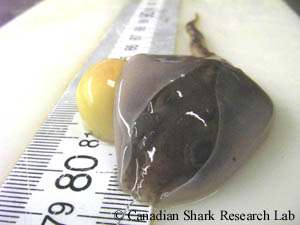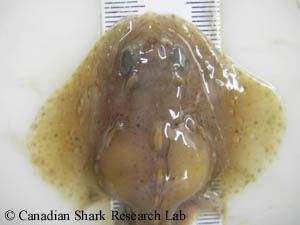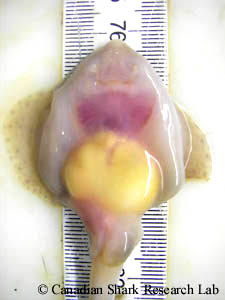Skate research
Despite recent reported declines in abundance of three of the most common species of skate in Atlantic Canada waters, very little is known about all species of Northwest Atlantic skate. Researching the life histories of skates and rays is an important step towards their conservation. For example, age information is crucial to our understanding of the resiliencies of species to exploitation as it forms the foundation for calculations of growth and mortality rates, age at maturity, and longevity. Here at the Bedford Institute of Oceanography, recent studies were undertaken to elucidate the critical life history characteristics of four species of skates (Family Rajidae) on the eastern Scotian Shelf off Nova Scotia, Canada: the winter skate (Leucoraja ocellata), the little skate (Leucoraja erinacea), the thorny skate (Amblyraja radiata), and the smooth skate (Malacoraja senta). More specifically, the following characteristics were examined for each species:
Age and Growth
Age and Growth
Ageing Background
Age information is crucial to our understanding of the life histories and associated resiliencies of species to exploitation as it forms the foundation for calculations of growth and mortality rates, age at maturity, and longevity. Cartilaginous vertebral centra are the most commonly used structures in age and growth studies on elasmobranchs, as they typically exhibit distinct annual growth increments visible as pairs of alternating opaque and translucent rings. This method is analogous to the use of otoliths (or earstones) to age bony fishes.
Recently, a skate ageing program was undertaken at the Bedford Institute of Oceanography's (BIO) Canadian Shark Research Lab (McPhie and Campana 2009a).
Age and growth information was collected on the winter skate (Leucoraja ocellata), the little skate (Leucoraja erinacea), the thorny skate (Amblyraja radiata), and the smooth skate (Malacoraja senta). The following page outlines the ageing procedures being used at BIO by Department of Fisheries and Oceans scientists, as well as some results. It should serve as a rough guide for those wishing to age Northwest Atlantic skates. Read through the entire section for a comprehensive outline of the methods, or click on one of the links below to quickly obtain information on the following:
Vertebrae Sampling
Cervical and thoracic vertebrae are preferable for ageing when compared to caudal vertebra because they have larger centra and more readily distinguished growth bands. During dissection, a segment of the vertebral column containing the first 20-25 vertebrae immediately posterior to the scapular origin is removed. Excising multiple vertebrae from each skate allows sufficient samples for experimentation. The piece is extracted by slicing the vertebral column at the base of the scapular origin and at a point midway along the pelvic girdle using a scalpel (Fig 1). Each section is then frozen separately and labeled with associated skate information (i.e. total length, disc width etc.).
Vertebrae Cleaning Techniques
Excess soft tissue is removed from the frozen vertebral segments using a scalpel and fine forceps. The individual vertebrae are then cut apart from each other and soaked in warm distilled water. Occasionally bleach (6% hypochlorite) is used to remove the last remaining bits of connective tissue from the vertebrae. However, bleach can decalcify cartilage when overused, so soak times are kept to a minimum (i.e. 3- 15 minutes depending on the size of the vertebrae). The vertebrae are then air-dried for no less than 48 hours.
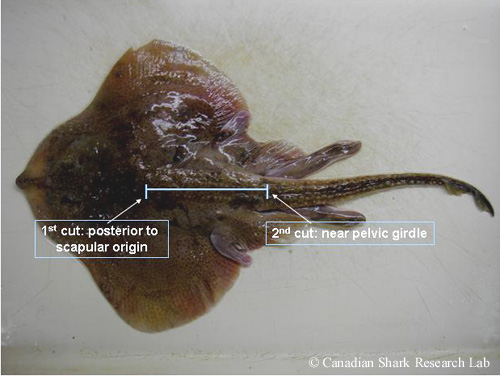
Diagram of a little skate (Leucoraja erinacea), with arrows demarking the locations where slices are made to extract a segment of the vertebral column for ageing.
Vertebrae Processing
Sectioned centra (rather than whole centra) are used to age skate as they depict growth bands more clearly, especially in the case of thorny and smooth skate and/or when examining the centrum edge. Specific vertebrae embedding and sectioning methods used at the Bedford Institute of Oceanography vary depending on the size of the skate vertebrae.
Large vertebra (3 7.0mm)
Vertebrae from the largest skates of all species that are greater than or equal to approximately 7.0mm in diameter are not embedded prior to sectioning. A low-speed Isomet saw with three diamond blades (i.e. BuehlerTM 4" blades) separated by spacers (0.5-0.7mm thick) is used to cut each centrum at its widest diameter, or along the mid-sagittal (i.e. longitudinal) axis. A number of centra from the same specimen are sectioned to allow for processing error. The resulting "bow tie" sections are then stored in 70% ethanol (ETOH).
Medium vertebra (4.0-7.0mm)
Vertebra that are less than approximately 7.0mm in diameter are either mass embedded, or in the case of the very small vertebrae, embedded separately in Araldite epoxy prior to sectioning. Mass embedding is a technique commonly used in bony fish age and growth studies which allows many ageing structures (i.e. hundreds) to be processed at a time. In skates, the transverse processes and neural arches are removed from each vertebrae using a scalpel. Tinted epoxy resin and hardener is poured into specially made plates, and centra are then firmly fixed in rows to the epoxy base layer in each plate suing 5-minute Epoxy glue (i.e. LepageTM number 12). This fixing technique is unique to skate vertebrae, and must be done in order to minimize displacement of the centra when the dense top coat of resin in applied. A top-coat of resin is applied; the plates are allowed to dry; and finally, plates are sectioned using a high speed, modified surface grinder with diamond bladed saws, resulting in vertebral thin sections approximately 0.5-0.7mm thick.
Small vertebra (<= 4.0mm)
Very small vertebrae of each species are embedded separately in Araldite epoxy prior to sectioning. Vertebrae (with neural arches intact) are placed in plates with shallow moulds that are then filled with a mixture of clear epoxy and hardener. After the epoxy is allowed to settle for 2-3 days, the individual "casts" are pushed from the mould and sectioned using the same low-speed diamond-bladed saw used to individually section large vertebrae.
Young-of-the-year and embryonic vertebra
It is extremely difficult to section the very smallest vertebrae of each species (especially species such as the smooth skate, which do not reach a very large maximum total length) using the above-mentioned techniques. For example, when dealing with young-of-the-year and/or embryonic vertebrae with diameters £1.0mm, sectioning through the focus can be almost impossible, with the width of the saw blades being almost equal to diameter of the centra. In these cases, the centra are fixed longitudinally to slides using Crystal BondTM and sanded or polished down to the focus (see next section). The resulting half-centra are then viewed and imaged.
Sanding/Polishing Vertebral Thin Sections
In cases where saw striations hinder band visibility, the thin vertebral sections are sanded and/or polished using a coarser lapping film (i.e. 3MTM aluminum oxide lapping film, 30 micron grade) followed by a finer lapping film (i.e. 3MTM aluminum oxide lapping film, 3 micron grade). Sections are sanded using a circular motion, and are viewed periodically to determine the appropriate amount required for readability. In most cases, only minimal sanding and polishing are required.
Staining/Soaking
A number of staining techniques involving calcium-binding chemicals such as alizarin red-S, crystal violet, and silver nitrate, as well as soaking techniques involving chemicals such as ethanol, have been attempted in an effort to enhance band resolution in elasmobranch vertebrae. Whereas these techniques have had some success in previous studies, in the case of NW Atlantic skates, band pair contrast does not seem to be improved with immersion in alizarin red-S or prolonged soaking in ethanol. Immersion of vertebral sections in 70% ethanol for periods ranging from 48 hours to 5 months did not appear to enhance band pair resolution either. As such, at BIO unstained and unsaturated sections were deemed the best for ring observation and subsequent ageing in all species.
Vertebrae Imaging

Vertebral section from a little skate (Leucoraja erinacea) enhanced using image analysis software. BB = birth band
In order to identify the growth bands, vertebral skate sections are viewed and digitally photographed under reflected light against a black background. All images at BIO are taken using a Nikon SMZ1000 dissecting microscope with a high resolution (2084 x 2048) Diagnostic Instruments SPOT CCD (charged coupled device) digital camera and Media Cybernetics Image Pro Plus 5.1 image analysis software. Vertebral images are then enhanced using Adobe Photoshop CS2 version 9.0.1 to improve sharpness and clarity.
Vertebral Ageing
Sectioned vertebral centra from NW Atlantic skates show band pairs consisting of a wide opaque band - which appears lightly coloured when viewed under reflected light against a black background - and a translucent band which appears darkly coloured. Opaque bands are thought to be areas of greater growth during the summer and translucent bands are thought to be deposited during the winter when growth rate is reduced. At BIO, skate ageing is carried out by counting the translucent bands in each section. Anomalous growth marks or inconsistencies - referred to as "checks" - are distinguished from true growth bands by irregular spacing and a fainter appearance. Inflections near the outside and inside edges of the corpus calcaria can also be useful to distinguish true bands. The corpus calcareum of each centrum with the most discernible band pairs is used to estimate age. Below are some images of vertebrae from winter, little, thorny, and smooth skates. White dots denote translucent bands. Click on the images to compare the differences between these species (Note: these are high resolution images, so the images will take somewhat longer to display).
Vertebral ring counts are used to create growth curves which show the average size of a skate at each age. Preliminary growth curves for winter, little, thorny, and smooth skate on the eastern Scotian Shelf (NAFO Divisions 4VsW) are shown below. Click on the images to compare the differences between species (Note: these are high resolution images, so the images will take somewhat longer to display). Although growth curves provide a good overall indicator of size at age, there are many factors that can influence growth in fish. For example, the health of an individual fish, its reproductive state, and the environmental conditions under which a fish lives can all effect growth rate.
Overall, results of work carried out to date the the Bedford Institute of Oceanography indicate that winter, thorny and smooth skate are relatively slow-growing, long-lived fishes, and are therefore vulnerable to over-exploitation. For a look at how old each of these species gets, go to the In Atlantic Canada section of this website, click on the species of interest, and go to the Life History section of each page.
Validation

A carbonate-derived reference chronology from NW Atlantic fish otoliths. Note the dramatic increase in radiocarbon between 1958 and 1965 (denoted by the shaded blue rectangle).
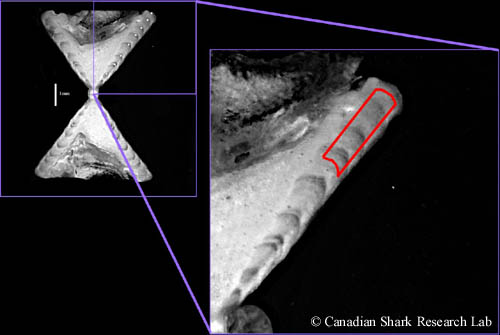
A vertebral section from a winter skate (Leucoraja ocellata). The red octangon shows the path followed by the micromill to extract the last three fully-formed growth bands. The first fully formed growth bands were extracted from other vertebral sections. The presumed year of sample formation, in each case, was the year corresponding to the midpoint of the sample.
Estimates of age, growth rate, and longevity in skates are all based on the assumption that vertebral rings are an accurate indicator of age. This is usually the case, although there are some species of elasmobranch - such as the Pacific angel shark (Squatina californica) - which do not lay down bands in a temporally consistent manner, making it impossible to use their rings to accurately determine age and growth characteristics. As such, confirmation of the accuracy of vertebral band deposition (known as age validation) is a crucial part of any age and growth study. Only a limited number of studies have been conducted on age and growth of NW Atlantic skate species, and to date, few have rigorously validated the temporal nature of the observed bands.
A number of methods exist for the validation of age estimates obtained from vertebral band counts. At BIO, attempts were made to validate the frequency of formation of growth increments through a mark-recapture of chemically-tagged wild skates which started in the summer of 2004 (for more information, go to the Mark-Recapture section of this website). This is the most rigorous of the indirect validation techniques. To date, however, there have been no recaptures from over 800 skate injected, tagged, and released.
Another age validation technique that has been used successfully on several shark species in both the NW Atlantic and the South Pacific is called bomb radiocarbon analysis. This technique relies on the fact that atmospheric testing of atomic bombs in the 1950s and 1960s resulted in an abrupt, worldwide increase in radiocarbon in marine organisms growing at that time. Ultimately, this resulted in a number of interchangeable radiocarbon chronologies based on known-age material (or reference chronologies) against which samples with unknown dates of formation can be compared. The most sensitive years for radiocarbon based ageing fall between 1958 and 1965 - the period of greatest increase in the reference chronologies.
Here at BIO, we conducted bomb radiocarbon analysis on winter and thorny skate. Individual growth bands were extracted using a computerized micro-milling machine, and sent off for analysis of their radiocarbon content. Results suggested that band counts are an accurate indicator of age in NW Atlantic skates. And interestingly, the radiocarbon content in the first formed bands of a mature male thorny skate collected in 1988 was pre-bomb (or formed prior to the prior of rapid increase), indicating that this individual was at least 28 years old! This is the oldest fully-validated age reported for any species of batoid!
In Summary
Ageing skates is not an easy task! Notable differences in growth band spacing and overall growth patterns exist between NW skate species, as do differences between and within vertebral samples from the same species. These discrepancies highlight some of the many difficulties associated with ageing skate, and the need to be as thorough as possible when undertaking a skate ageing study. Age validation is also very difficult and time consuming. Further investigation into the temporal nature of band deposition in NW Atlantic skates - and skates and rays in general - is required. However, don't be discouraged! Accurate estimates of age, growth and longevity are desperately needed for skate and ray species around the world in order to access the current and future status of these fascinating creatures, and to implement effective conservation measures. Good luck!
Egg Capsules
Egg Capsules
The egg cases (sometimes call mermaids purses) of oviparous elasmobranchs vary widely in size, shape, and structure. However, the basic design is similar. The body of the capsule is usually convex or curved dorsally and is relatively flat on the other side. All egg capsules are also equipped with structures that serve as anchoring devices. The egg capsules of skates, for example, have long "horns" or tendrils growing from each corner of the capsule. In the oviduct of the female, the longer posterior horns of the egg capsule develop first, followed by the body of the capsule and then finally the shorter, more curved anterior horns. Capsules are also covered or felted in masses of loose sticky fibers, which presumably stick to structures on the bottom. However, naturally deposited purses have never been observed in situ, leaving it unclear how exactly anchoring is effected.
The egg capsules of skates can be distinguished by their shape and by their size and the length of their tendrils relative to the capsule body. For a more detailed description of and/or a closer look at some of the capsules of NW Atlantic skate species, click on the link Identification of NW Atlantic Skate Egg Capsules. Also included in this page is an identification key of Scotian Shelf skate egg capsules.
Although remarkably durable, the egg cases of skates are nonetheless preyed upon by a wide variety of predators ranging from burrowing gastropods to larger shark species, and may suffer heavy mortality. In fact, empty skate egg capsules have been found with evidence of predatory activity. For more information on predation on embryonic skates, see the Feeding section.
Egg Capsule Identification
Egg Capsule Identification
The following page provides photos and descriptions of some of the egg capsules of skate species common to the NW Atlantic. The identification key was compiled at the Bedford Institute of Oceanography, and pertains only to the most common species of skate found on the Scotian Shelf. Other photographs were provided by scientists from the Marine Fish Species at Risk Section at the Northwest Atlantic Fisheries Center, and were collected in waters around NewFoundland.
Identification Key of Scotian Shelf Skate Egg Capsules
after Vladykiv
Key compiled by Jim Simon, Population Ecology Division, Bedford Institute of Oceanography
1. Capsule over 100 mm long, trapezoidal in shape and slightly convex on both sides. Horns strong and short, length less than half length of the capsule. Capsule 124 to 132 mm long, 66 to 74 mm wide.....Barndoor skate (Dipturus laevis)
Capsule less than 100 mm in length, various shapes but not trapezoidal. Horns moderately or extremely long, length more than half the length of the capsule.....2 or 4
2. Capsule rather square, with one side (ventral) almost flat and the other (dorsal) highly convex, with a clearly visible lateral membrane. The longer pair of horns (posterior pair) does not exceed the length of the capsule. Exterior of capsule smooth. Capsule 56 to 59 mm long, 39 mm wide.....Smooth skate (Malacoraja senta)
Exterior of capsule rough and transversely striated.....3
3. Capsule 66 to 90 mm long, 48 to 73 mm wide. (However, capsule size varies considerably with region of capture and relates significantly to size of gravid female).....Thorny skate (Amblyraja radiata)
4. Capsule rather cylindrical. Highly convex on both sides, with no lateral membrane. Longer pair of horns (posterior pair) exceed the length of the capsule. Capsule 55 to 63 mm long, 35 to 45 mm wide. Browbordern to dark browbordern in colour.....Little skate (Leucoraja erinacea)
Capsule 75 to 86 mm long, 44 to 52 mm wide.....5
Photo not available
5. Egg capsules greenish browbordern to olive browbordern in colour.....Winter skate (Leucoraja ocellata)
Egg Capsules of NW Atlantic Skate Species (collected around NewFoundland)
Mark-Recapture
Mark-Recapture
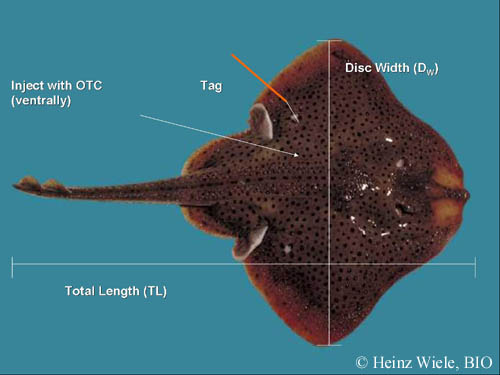
Diagram of a mature female winter skate (Leucoraja ocellata) showing the measurements taken onboard ship and the tagging and injection locations.
Tagging and recapturing fish can reveal lots of interesting information about a species' biology and ecology. For example, recaptures can yield information about a species' growth rate as well as reveal possible migration patterns. At the Bedford Institute of Oceanography (BIO), a skate mark-recapture program was started in the summer of 2004 with the Fishermen and Scientists Research Society (FSRS) to help determine age and growth, migration pathways, stock discreteness, and population abundance of all species of skate on the eastern Scotian Shelf off Nova Scotia, Canada.
On board ship, skates were deemed in relatively good shape for tagging based on the following criteria:
- No visible or extensive trawl wounds
- Minimal abrasions on the skin from the thorns and spines of other fish
- Active spiracles
- A fair amount of pectoral fin flapping and jaw gaping
Skates were then tagged with either a T-bar or dart-tipped tag, with the size of the tag dependent on the size of the skate. A single tag was inserted dorsally into the fleshy part of the pectoral fin of each skate, towards the posterior end. Efforts were made to tag and inject juveniles and adults of each species.
Tagged skates were also injected intra-peritoneally with a veterinary antibiotic called oxytetracycline (OTC). This is a chemical commonly used in age and growth studies on fish, as it deposits at sites of active calcification (i.e. in vertebral centra, for example) and can remain distinct for some time. More specifically, in the event of a recapture, the calcified structures of the individual can be examined and the time at liberty can be compared with the number of bands deposited distal to the mark, allowing one to validate age estimates obtained from vertebral band counts. Validation is a crucial part of any age and growth study, and a mark-recapture of chemically-tagged wild fish is one of the most rigorous, indirect means of validating the frequency of formation of growth increments.
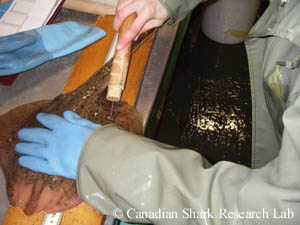
A large female winter skate (Leucoraja ocellata) being tagged with a dart-tipped tag onboard the MV Teleost
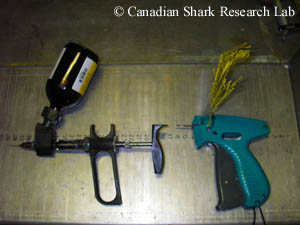
An oxytetracycline (OTC) injection gun and a conventional T-bar tagging gun used for the mark-recapture of Northwest Atlantic skates
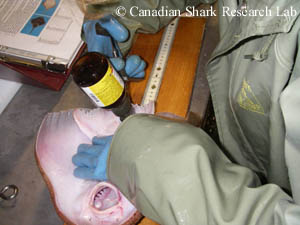
A maturing female winter skate being injected ventrally with oxytetracycline (OTC) onboard the MV Teleost
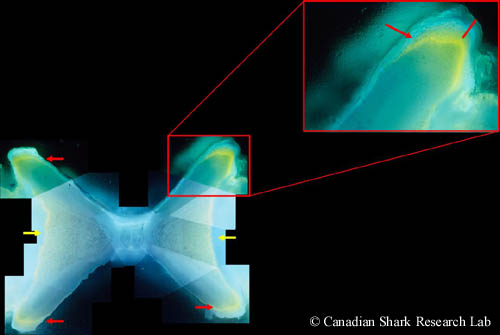
Photographs taken under ultraviolet (UV) light (340-350 nm) of the vertebrae of an immature male winter skate (Leucoraja ocellata) injected with oxytetracycline (OTC) and held in captivity for 12 months. The deposition of the chemical OTC tag is clearly visible in the growing edges of the corpus calcarea (red arrows) and the intermedialia (yellow arrows), as is growth distal to the mark (red bar).
Unfortunately, to date there have been no recaptures from over 800 skate injected, tagged, and released on the eastern Scotian Shelf. Captive rearing of skates within the laboratory at BIO has revealed that OTC is incorporated in the cartilaginous structures of each species, suggesting that mark-recapture is a suitable validation method in northwest Atlantic skates. However, the failure of the wild mark-recapture to date raises some interesting questions, such as what the discard mortality of northwest Atlantic skates is and what their temperature and pressure sensitivities are.
If you should happen to catch a skate tagged with a yellow T-bar (Floy) or dart tag, please return the whole frozen fish with the following information:
- Date of capture
- Name/ phone # / address of person returning tag and fish
- Position caught (latitude and longitude)
- Depth and water temperature at location of capture
- Method of capture
- Tag number and skate length
Contact the Canadian Shark Research Lab so that the fish can be picked up by a fisheries technician.
Reproduction
Reproduction
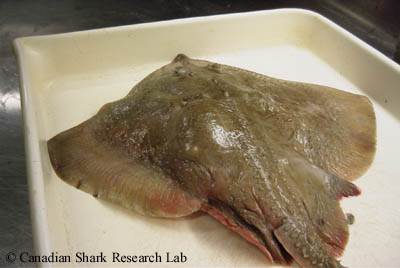
Dorsal/ posterior view of a mature female thorny skate (Amblyraja radiata). Egg cases within the genital tracts are visible externally as a pair of prominent swellings anterior to the base of the tail on either side of the midline.
Background
Knowledge of the reproductive characteristics of a species is key to both assessing vulnerability and to proper management. For example, age-at-maturity and fecundity are important life history parameters as they can greatly affect a species' resilience to exploitation and extinction. However, despite recent reported declines in abundance of skate in Atlantic Canada waters, much remains to be learned about the reproductive biology of even the most common species. A recent study carried out at the Canadian Shark Research Lab at the Bedford Institute of Oceanography aimed to estimate size- and age-at-maturity and fecundity, and to discern seasonal patterns in reproductive output for the winter skate (Leucoraja ocellata), the little skate (Leucoraja erinacea), the thorny skate (Amblyraja radiata), and the smooth skate (Malacoraja senta) on the eastern Scotian Shelf (ESS) (NAFO Divisions 4VsW) off Nova Scotia, Canada (McPhie and Campana 2009b).
Maturity
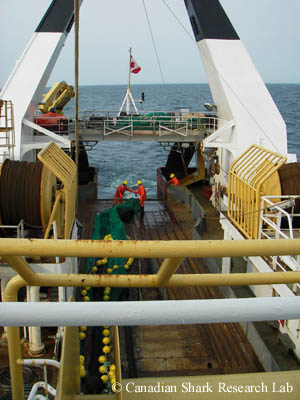
A trawl being hauled back aboard the Canadian Department of Fisheries and Oceans research vessel (RV) the MV Teleost
In order to carry out reproductive analyses, skates are collected aboard commercial fishing vessels and research vessels (RV). Trawls are the most effective means of capturing skate, although the larger species (especially thorny and barndoor skate) are also captured on long-lines by fisheries targeting other species, such as halibut (Hippoglossus stenolepis). Fish are frozen onboard for detailed analysis of their reproductive tracts back at the laboratory.
Once back at the lab, skates are thawed, total lengths and total weights are taken, and the sex of each specimen is noted. Gross morphological analyses are then carried out in order to classify each specimen into a maturity or spawning stage. Both external and internal reproductive characteristics are examined. For a detailed description and photos of each of the reproductive structures examined in male and female skates, go to the Internal Anatomy section of this website.
In males, the length and "state" (or rigidity) of the claspers are determined. The length of the clasper is measured on the inside edge from the point of insertion to the tip of the clasper. Clasper rigidity (or the degree of calcification) is assessed as either "uncalcified" when the organ is soft and easily bent; "plastic" when the organ is flexible but showing some structure and development of the tip (or glans); or "calcified" when the organ is completely stiff and resistant to deformation. In calcified claspers, the glans structures also open readily upon flexion. Males with long, calcified claspers are classified as mature.
Other indices of maturity in males that are recorded during dissection are:
- Testes weight (including weight of the epigonal organ due to its close association with the gonads)
- The development (or bulging) of the testicular lobes
- The diameter and shape of the epididymis and the vas deferens at their widest points
- The presence of sperm in the lower part of the ductus deferens
- The presence, total number, and state (soft, semi-soft, hard) of alar thorns
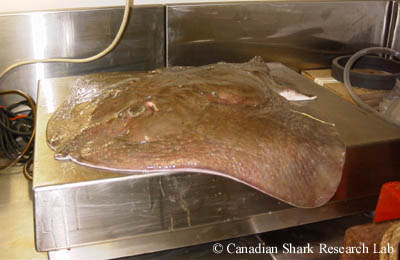
A mature female thorny skate (Amblyraja radiata) being weighed (total wet weight, kg) in the laboratory
In females, it is difficult to tell whether a female is mature from the exterior alone, unless she has egg cases within her genital tracts visible as a pair of prominent swellings anterior to the base of the tail on either side of the midline. As such, an examination of the internal reproductive organs is necessary. The following reproductive organ characteristics are examined:
- Uterus diameter
- Shell gland diameter
- Ovary weight
- Shell gland weight
- Total number and state of ovarian follicles
- Average diameter of the five largest ovarian follicles
- Presence/absence and state of egg capsules
When egg capsules are found, they are removed from the reproductive tract of the mother, and egg capsule weight and yolk weight are determined. Females are classified as mature when they have egg capsules within their reproductive tracts, or when they have yolked ova and shell glands similar in size to those of spawning stage females.

The ovary of a mature NW Atlantic skate. Calipers are used to measure the diameters of the five largest vitellogenic follicles.

Maturity ogives for male and female little skate (Leucoraja ocellata) on the eastern Scotian Shelf (NAFO Divisions 4VsW). The solid line is the maturity ogive for males, and the dashed line in the maturity ogive for females.
Size- and age-at-maturity are then determined for each species using maturity ogives. Maturity ogives are plots of proportion mature against size or age. The inflection points of logistic curves fit to maturity ogives can be used to accurately estimate size- and age-at-maturity (Figure 8). Click on the image below to see maturity ogives for male and female little skate on the eastern Scotian Shelf. (Note: this is a high resolution image, so it will take somewhat longer to display).
Overall, results of work carried out to date the the Bedford Institute of Oceanography indicate that winter, thorny and smooth skate are relatively slow-growing, late-maturing, long-lived fishes, and are therefore vulnerable to over-exploitation. For a look at how old each of these species gets and to find out at what sizes and ages males and females of each species mature, go to the In Atlantic Canada section of this website, click on the species of interest, and go to the Life History section of each page.
Fecundity
Determining fecundity (or annual egg production) in NW Atlantic skates is extremely difficult because they are "serial spawners" that spawn multiple times each year, throughout the year. Mature females have large yolked ova and many small white ova of all sizes in their ovaries during every month of the year, with smaller eggs maturing constantly to replace those that are encapsulated and oviposited (see Female Reproductive Tract). This reproductive strategy makes it impossible to use counts of the number of mature ova in the ovaries of each species during the months of peak production to estimate the maximum number of eggs produced between then and the end of the spawning season, a method that has been used to estimate fecundity in ray species. As such, fecundity in skates is determined indirectly. The size of "immature" ova is determined for each species using ova diameter frequency distributions, and then the number of ova with diameters exceeding this size (called "mature ova") in the ovaries is determined for each mature female. This number is averaged across all mature females sampled to estimate a potential fecundity value for each species.
The following potential fecundity values were obtained for winter, little, thorny and smooth skate on the eastern Scotian Shelf off Nova Scotia, Canada:
| Winter skate (Leucoraja ocellata) | Little skate (Leucoraja erinacea) | Thorny skate (Amblyraja radiata) | Smooth skate (Malacoraja senta) |
|---|---|---|---|
| 52 eggs/yr | 41 eggs/yr | 56 eggs/yr | 51 eggs/yr |
Reproductive cycle
Seasonal patterns of mating and reproduction can be determined by examining reproductive organ characteristics by month of collection. In male and female skates, characteristics that have been found to change over the course of a reproductive cycle include:
- Average follicle diameter
- Ovary weight
- Shell gland weight
- Number of vitellogenic (or yolked) follicles
- Testes weight
- Seminal vesicle diameter
- Epididymis width
Peaks in these characteristics can be indicative of periods of enhanced reproductive activity, especially if peaks are coincident between males and females of the same species. Other, detailed studies have used steroid hormone concentrations and testes histology along with morphological measurements of the reproductive organs of males and females to determine the reproductive cycles of the winter and thorny skate in the Gulf of Maine. Most studies on skate to date indicate that they either reproduce year round (i.e. thorny skate Amblyraja radiata in the Gulf of Maine), or have partially defined reproductive cycles with one or two peaks when a greater proportion of the population is reproductively active (i.e. winter skate Leucoraja ocellata in the Gulf of Maine). On the eastern Scotian Shelf, it appears as if thorny and smooth skate (Malacoraja senta) are capable of reproduction year round, with thorny skate showing potential peaks in May and October. Unfortunately, a lack of mature female winter and little skate (Leucoraja erinacea) on the ESS precluded a determination of their reproductive cycles in this area.
Development
Development
During the early stages of development within the egg case, the ovum and associated yolk mass are not structurally self-supportive, but are stabilized by a clear, gelatinous egg jelly, often referred to as the albumen. The albumen fills the interior of the egg capsule not occupied by the egg itself, and serves to contain and limit the movement of the delicate ovum within the egg capsule during the initial one third of the incubation period. It also functions as a plug for the respiratory canals found on either side of the egg case at the base of the anterior horns. As the yolk develops its own self-supportive external membranes, the albumen gradually decreases in viscosity and then dissolves completely, opening the respiratory canals and allowing for ventilation and oxygenation of the interior environment. The time required for the canals to become fully unplugged and for seawater to enter freely through one of both ends of the egg case is likely a function of incubation temperature; in the clearnose skate (Raja eglanteria), for example, the process takes approximately 25-28 days. For the remaining two thirds of incubation, the embryo develops in seawater. During this time, water flow and gas exchange is aided by the embryo, which constantly beats its elongate tail to facilitate the movement of water into and out of the egg case through the open respiratory canals. External gill filaments aid in respiration prior to the formation of gills.
As development continues, the external yolk sac slowly diminishes in size and the embryo orients itself so that its rostrum faces the anterior end of the egg case (or the posterior part of the egg capsule in relation to the genital tract of the parent fish). The pectorals are folded dorsally over the body and the tail is rotated 180° so that the fanning motion continues to circulate seawater towards the gills of the embryo.
After a developmental period lasting from a couple of months to over a year, the fully-formed skate emerges suddenly from the end of the capsule, pushing itself through a ruptured slit between the two anterior horns. A small internal yolk-sac measuring approximately 1-3mm in diameter is present at the time of hatching. During the first week post-hatching, this sac is resorbed completely, after which the young skate must feed for itself.
Classification
When scientifically classified, there are approximately 631 different species of skates and rays (or batoids) belonging to 23 families, representing approximately 55% of the world's extant (or living) cartilaginous fishes. The current classification system of skates and rays, however, is still in dispute, as much remains to be learned about the evolutionary lineages and relationships among elasmobranch species. For example, the skates, rays and guitarfishes are generally recognized as a monophyletic group; however, depending on the classification, they can be listed as belonging to the superorder Squalea or the superorder Batoidea, and occasionally they are all listed under one order (Rajiformes) instead of under separate orders. The following classification is commonly used, and follows that presented in Sharks, Skates, and Rays: The Biology of Elasmobranch Fishes (1999) [edited by William C. Hamlett].
KINGDOM: Animalia
PHYLUM: Vertebrata
CLASS: Chondrichthyes (cartilaginous fishes)
All cartilaginous fishes share a number of characteristics that separate them from bony fishes, beyond that of a cartilaginous skeleton. For example, they have the following characteristics in common (among others):
- The cranium (or skull) is a box-like container for the brain and sense organs of the head.
- The upper jaws are not fused to the cranium, and are capable or being protruded. The lower jaw is a single element on each side.
- The teeth are present in replicating rows, which replace one another in a conveyer-belt fashion.
- There are 4 to 7 internal and external gill openings.
- They lack lungs or swim bladders.
- The vertebral column is essentially a notochord supported by calcified vertebral centra.
- In males, the skeleton of the pelvic fins is modified into paired copulatory organs called claspers.
- Most have a covering of tiny placoid scales (or dermal denticles).
- There is usually a preoral snout with the nostrils on the ventral surface.
SUBCLASS: Elasmobranchii (shark-like fishes)
SUPERORDER: Rajomorphii or Batoidea (batoids)
All skates and rays (or batoids) are clearly related to one another. They share the following characteristics:
- Ventral gill openings.
- Eyes and spiracles on top of the head.
- Enlarged pectoral fins that attach to the side of the head.
- Lack of an anal fin.
- Pavement-like teeth for crushing their prey.
For more information on the external and internal anatomical characteristics of batoid fishes, go to the External Anatomy and Internal Anatomy sections of this website.
ORDERS: Pristiformes (Sawfishes), Rhiniformes (Wedgefishes), Rhinobatiformes (Guitarfishes), Torpediniformes (Electric Rays), Myliobatiformes (Stingrays)
There are many FAMILIES of batoids within the above orders. The four species of rays found in Atlantic Canada waters belong to the following FAMILIES:
- FAMILY: Torpedinidae (torpedo rays)
- FAMILY: Dasyatidae (whiptail stingrays)
- FAMILY: Mobulidae (devil rays)
ORDER: Rajiformes (Skates)
There are three FAMILIES of skates:
- FAMILY: Arhynchobatidae (softnose skates)
- FAMILY: Anacanthobatidea (legged skates)
- FAMILY: Rajidae (skates)
Skates (FAMILY Rajidae) are the most species-rich family of all the Chondrichthyes, (i.e. at least 136 species) and are the most common batoids encountered in Atlantic Canada waters. They can be distinguished from other families of batoids by the following characteristics:
- Relatively thin, subcircular to trapezoid-shaped disk.
- Rostrum usually not reduced, with a stiff snout.
- Slender tail (usually without a caudal fin or with a poorly developed caudal fin) with lateral electric organs and two small dorsal fins.
- Pelvic fins divided into anterior and posterior lobes (bilobate) but are not leg-like.
- Pelvic fins usually partially overlapped by the posterior extension of the pectoral fins.
- Most species bear thorns.
- The clasper glans are greatly expandable.
They are often abundant in temperate waters around the world from nearshore to depths greater than 1000 m. It is not uncommon to find several species occurring together in the same environment, although there is speculation that each species' occupies a different niche, segregating by subtle ecological factors such as temperature, depth and prey preferences.
Skate or Ray?
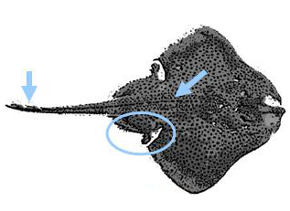
A skate, with important characteristics highlighted.
- Most have enlarged thorns along the midline of the back extending onto the tail.
- Pelvic fins have two lobes (bilobate).
- Tail relatively stocky without a stinging barb, and usually with two small dorsal fins near its tip. The caudal fin is tiny, when present.
- Mature males have enlarged spines near the eyes (malar spines) and pectoral wingtips (alar spines)
- Lay Eggs (oviparous reproduction)
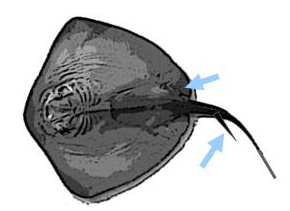
A ray, with important characteristics highlighted.
- No thorns (or bucklers) along the midline of the back.
- Each pelvic fin has only one lobe.
- Tail is very slender and whip-like with a stinging spine midway along its length and usually without a dorsal fin. When a dorsal fin occurs, it is near the base of the tail. The caudal fin is either reduced and contiguous or absent.
- Mature males do not have malar or alar spines.
- Give live birth (viviparous reproduction)
Conservation
In General

Northwest (NW) Atlantic skate egg capsules caught in an otter trawl and brought back to the lab for dissection
Compared to terrestrial and freshwater species, few marine fishes are formally recognized as threatened or endangered. This might be due - in part - to a lingering assumption that marine species occupy greater ranges and are more mobile that terrestrial animals, and that rarity or absence in one area is likely counteracted by high abundance in another. This situation, however, may be changing as more is understood about the marine ecosystems of the world. For example, it was recently recognized that intensive trawling of one of the largest and most common species of skate in the northwest Atlantic, the barndoor skate (Dipturus laevis), brought about its near extinction, despite this species having a relatively wide distribution. This recognition led the World Conservation Union (IUCN) to list the barndoor skate as "endangered", and the US to prohibit catch of this species until its biomass had recovered from its overfished condition.
The causes for declines in fish diversity and abundance are numerous. In general, human-related stresses can be divided into four components:
- Exploitation
- Introduction of nonnative species
- Habitat alterations
- Pollution
Because fish tend to be concentrated on continental shelves and around islands, these stresses often act together to bring about declines. However, of these stresses, exploitation is likely the major cause of changes in fish populations. Elasmobranch populations are particularly susceptible to over-fishing as they tend to be unproductive compared to other fishes. Moreover, the effects of direct removal, of bycatch, and of habitat alteration from fishing are often difficult to disentangle, making conservation of all marine fishes a challenging task. Nevertheless, efforts are being made around the world to assess the status of marine fishes, and steps are being taken towards marine species' conservation. For example, in the case of batoids, the IUCN Shark Specialist Group convened in 2004 to assess the international conservation status of batoids and to address some of the problems their populations face. Species that were deemed most at risk included:
- Inshore species with limited distributions (i.e. the Java stingaree, Urolophus javanicus)
- eepwater species affected by expanding fishing at ever-increasing depths (i.e. Australian Dipturus spp.)
- Freshwater and estuarine species susceptible to habitat alteration (i.e. South American Colares stingray Dasyatis colarensis)
- Wide-ranging species targeted for the international fin trade (i.e. guitarfishes of the family Rhinobatidae)
Species at Risk
Luckily, several international and national organizations exist to make recommendations on the conservation of species deemed endangered or threatened. As a country, Canada subscribes to the Food and Agriculture Organization (FAO)'s International Plan of Action on Sharks and Rays. In 2007, Canada released its own National Plan of Action for the Conservation and Management of Sharks, a plan for the conservation long-term sustainable use of "sharks" (a term applied broadly to include all species of elasmobranch, including skates and rays). Finally, under the Canadian Species at Risk Act (SARA), the population status of potentially endangered wildlife in Canada is reviewed by the Committee on the Status of Endangered Wildlife in Canada (COSEWIC), which then categorizes each population based on abundance and health indices. Recommendations are then passed to the Canadian federal government for possible action under SARA. For more detailed information on the COSEWIC assessment process, visit their website.
- Southern Gulf population - Endangered
- Eastern Scotian Shelf population - Threatened
- Georges Bank - Western Scotian Shelf - Bay of Fundy population - Special Concern
- Northern Gulf - NewFoundland population - Data Deficient
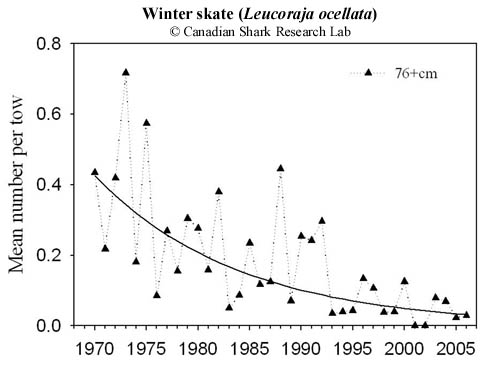
Stratified mean number per tow of adult winter skate (Leucoraja ocellata) from July research vessel (RV) survey data collected on the eastern Scotian Shelf (NAFO Divisions 4VsW). The solid black line indicates the exponential decline rate.
Species' listed by COSEWIC as endangered or threatened are deemed to "possess life history characteristics that increase their vulnerability to exploitation, that reduce their rate of recovery, and that increase the risk of extinction". In the winter skate, these characteristics include delayed ages at maturity, long generation times, relatively low fecundities, and correspondingly slow population growth rates. Winter skate in the southern Gulf of St Lawrence mature at a significantly smaller size and reach smaller overall sizes than those found elsewhere in Canadian waters, including the eastern Scotian Shelf, suggesting restricted distributions for each population. Moreover, abundance of mature individuals was estimated to have declined by 98% in the southern Gulf and by more than 90% on the eastern Scotian Shelf since the early 1970s, due in most likelihood to unsustainable rates of catch in other groundfish fisheries. For a more comprehensive review of the status of the winter skate in Canadian waters, take a look at the two Recovery Potential Assessment (RAP) documents released for winter skate in 2006. The first RAP (RAP CSAS 2006/003) covers the biology, status and current threats facing winter skate in NAFO Divisions 4T and 4VW, while the second RAP (RAP CSAS 2006/004) discusses the population models used in the COSEWIC assessment. (Note: these are large PDF files, so they make take some time to download).
Along with the winter skate, other species of NW Atlantic skates are in the process of being reviewed by COSEWIC, or have been chosen for assessment. Assessments of the available scientific information for thorny skate (Amblyraja radiata) and for smooth skate (Malacoraja senta) were conducted in 2004 and 2006, respectively, and the barndoor skate (Dipturus laevis) is up for initial evaluation by COSEWIC in 2008. For a detailed review of the available scientific information on smooth skate in Canadian waters (with reference to its global distribution) take a look at the Canadian Science Advisory Secretariat Research Document 2006/093. (Note: this is a large PDF file, so it make take some time to download). A recent study on the population abundance trends of four skate species on the eastern Scotian Shelf (NAFO Divisions 4VsW) indicated that - along with winter skate (Fig. 2) - adult thorny and smooth skate have declined dramatically in abundance since 1970, suggesting these species are also at risk (Fig. 3 and Fig. 4). Unfortunately, very little scientific information is available on the other species of skate in Atlantic Canada waters, precluding an assessment of extinction risk.
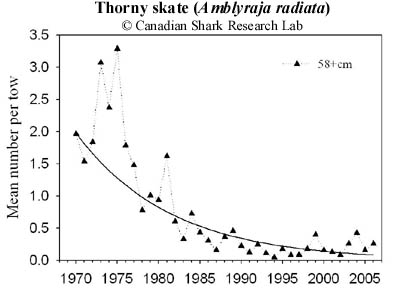
Stratified mean number per tow of adult thorny skate (Amblyraja radiata) from July research vessel (RV) survey data collected on the eastern Scotian Shelf (NAFO Divisions 4VsW). The solid black line indicates the exponential decline rate.
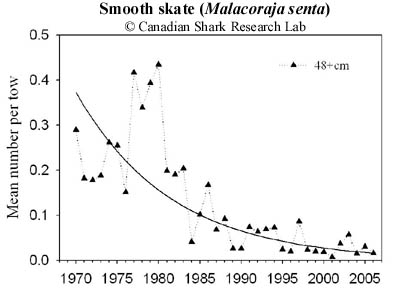
Stratified mean number per tow of adult smooth skate (Malacoraja senta) from July research vessel (RV) survey data collected on the eastern Scotian Shelf (NAFO Divisions 4VsW). The solid black line indicates the exponential decline rate.
Other Steps
Finally, in Atlantic Canada, in recognition of the potential vulnerability of skate populations to depletion, additional steps are being taken towards skate conservation. Department of Fisheries and Oceans (DFO) scientists are currently seeking to better understand more about the life histories and population dynamics of skate species residing in Atlantic Canada waters, so that each species can be properly managed. More specifically, studies are being conducted on the age and growth, maturity, reproduction, and population viability of a number of skate species residing in waters off NewFoundland, in the Gulf of St. Lawrence, and on the Scotian Shelf. To learn more about how research on skates is conducted at the Bedford Institute of Oceanography and elsewhere, and for some of the results collected to date, go to the Skate Research section of this website.
- Date modified:
